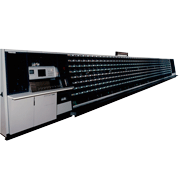The TT-200 mail sorter went into operation when the new postal code system (seven digits) went into effect in February 1998. The TT-200 was able to read addresses down to the district numbers, house numbers, and apartment numbers to sort mail items into the correct delivery route sequence.
Automated mail item sorting requires recognition of addresses in the order of post office [Note 1], delivery route [Note 2], and delivery route sequence. [Note 3] With the TT-200, mail items could be sorted into the correct delivery route sequence because it could recognize addresses (district, block, house number, apartment number, building name, and room number). When developing the mail sorter, it was necessary to recognize each character correctly on its own, because the readable characters in addresses are few in number — mostly numbers — and have little redundancy compared to kanji character recognition. Furthermore, the mail sorter had to handle many variations, such as the inclusion or omission of the building name and irregular street naming conventions such as the agaru / sagaru variations in Kyoto. Toshiba later developed the TT-210, which consumed less power.
- Able to recognize prefectures, municipalities, districts (district, block, building, apartment number), building numbers, and room numbers
- Able to process 30,000 mail items per hour
- 250 sorting slots
- Assortment algorithm: sort into multiple paths with a cardinal number sorting method
Note 1: Post office sorting: sorting submitted mail items to the destination post offices
Note 2: Delivery route sorting: sorting mail items to individual delivery routes
Note 3: Delivery route sequence: ordering mail items in the sequence the postal delivery worker delivers mail along the delivery route


